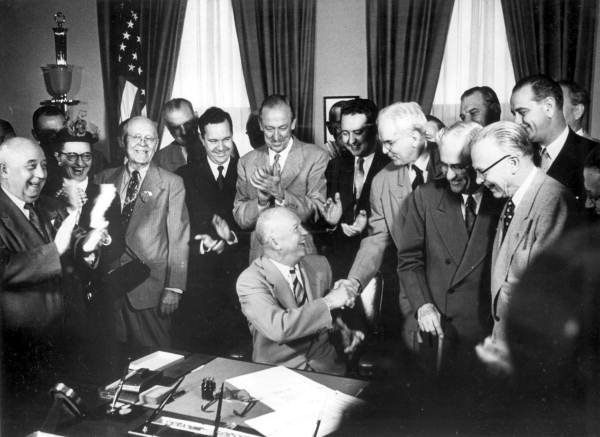[ad_1]

The postwar era was a time defined by unparalleled prosperity. Subsequent the Second Environment War, returning GI’s came household to a booming economy, housing enhancement jobs, and assist packages like the GI Invoice that expanded and cemented America’s center class. By 1950 most factories, together with automobile producers, had made the transition from wartime production to a shopper-dependent overall economy, so substantially so that, in that yr alone, 8 million autos ended up generated, by 1958 much more than 67 million vehicles would be created and registered in the United States. Even so, at the get started of the 10 years, most of America’s obsolete roads were being in no ailment to support a enormous influx of targeted visitors. Tension for construction of transcontinental superhighways experienced been developing because the late 1930s, even so, conflict among city pursuits and rural interests vying for priority and a deficiency of funding remaining early jobs such as the 1944 Federal-Help Highway Act lifeless in the water. By the 1950’s, in purchase to handle an inflow of new auto homeowners president Dwight D. Eisenhower publicly supported an interstate highway growth system and on June 29, 1956, he signed the Freeway Profits Act also known as the Nationwide Interstate and Defense Highways Act into regulation. The act marked the biggest American general public operates method of that time authorizing the building of 41,000 miles of interstate highways fitted with overpasses and minimal-accessibility belt traces. Eisenhower experienced been closely affected by his activities in 1919 as a participant in the U.S. Army's initially Transcontinental Motor Convoy across the United States and his observations of the German audubon freeway network in the course of Earth War II. Possessing acknowledged the importance of mobility and effectiveness, Eisenhower proposed an American interstate highway method in his Condition of the Union handle in 1954, which he framed as a nationwide protection method. In an effort to stimulate a cooperative alliance involving state and federal officers, retired Common Lucius D. Clay, an engineer and a extensive-time advisor to the president, proposed a system in which the federal government would pay 90 p.c of the value of expressway design the funding for which would come from an elevated gasoline tax (now 3 cents a gallon). Interstate money were to then be distributed in the ratio of every single point out's believed charge of completing the technique. The initially job beneath the Act was the Mark Twain Expressway (Interstate 70) in St. Charles County, Missouri.
The highways ended up supposed to remove traffic congestion replace “undesirable slum locations with pristine ribbons of concrete” as one highway advocate place it make coastline-to-coast transportation additional successful and make it uncomplicated to evacuate major metropolitan areas in case of an atomic assault. While transformative, the Highway Income Act also mirrored an enduring legacy of Jim Crow period discriminatory guidelines and systemic racism. Small-expense mortgages by the G.I. Bill (which was not provided to black GI’s), enabled white people to abandon internal towns in favor of suburban housing as nicely as reduce ethnic minorities from performing the identical. Federal planners of the interstate highway method routed some highways right, and often purposefully, by means of predominantly black and brown neighborhoods to predominantly white suburban neighborhoods. Despite the fact that the Freeway Profits Act was initially met with popular community support, as additional people turned displaced and conditions in cities deteriorated, activists commenced to openly oppose the process, some likely as significantly as forcing construction stoppages through the late 1950s and early 60s. In the course of the 1960s, civil legal rights activists and environmentalists throughout the country in New York Metropolis, Baltimore, Washington, D.C. New Orleans and other metropolitan areas managed to protect against roadbuilders from dividing and subjugating their neighborhoods, sooner or later even so, most of the 41,000 miles of interstate ended up finished.
Sources:
https://www.senate.gov/artandhistory/record/moment/Federal_Freeway_Act.htm#:~:textual content=On%20June%2026%2C%201956%2C%20the,Eisenhower%20signed%20it%20into%20law.
https://www.npr.org/2021/04/07/984784455/a-quick-history-of-how-racism-shaped-interstate-highways
https://www.theatlantic.com/business/archive/2016/03/function-of-highways-in-american-poverty/474282/
https://highways.dot.gov/public-streets/summer time-1996/federal-support-freeway-act-1956-making-interstate-procedure
[ad_2]
Source backlink





More Stories
2022 Porsche Taycan 4 Cross Turismo Pros and Cons Review: Wag Swag?
How to Fix an Inflatable Water Slide: The Four Most Common Problems
The Importance of Replacing Outboard Powerhead Gaskets